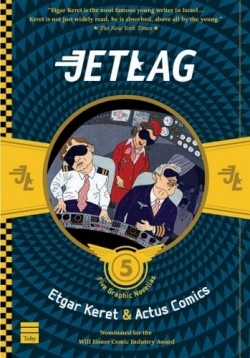Jetlag
Bold colors and a variety of illustrating styles mark this collection of five haunting, poignant, and strange tales by an award-winning Israeli writer whose works have appeared everywhere from American and French publications to the Israeli stage.
In “HaTrick,” the main character, a magician, relates how he used to love pulling the rabbit out of the hat in his magic act. He’d save it till the end, because kids seemed to love; he’d let them pet and feed the rabbit afterwards. However, at a party at which the children are bored and uninterested, all that comes out of the hat is the rabbit’s head, and “lots and lots of blood.” The kids become excited and happy; the magician leaves, distressed, and then is besieged by parents who want to hire him for their kids’ parties.
After that, every time he performs the trick, he’s nervous and frightened, and the results grow worse. It’s no longer “the best of times for rabbits or for babies,” he says, mystified and sorrowful. While the story is graphic, the illustrations are not gruesome. The characters’ eyes are memorable, causing readers to wonder what’s wrong with children who are happy to see such tragic events—and with their parents.
“Margolis” is the tale of a child who learns from a piggy bank what love means. The boy is upset because his father, instead of buying him the Bart Simpson skateboard he wants, gives him a piggy bank so that he can learn the value of money. The boy finds the bank ugly at first. But the pig always smiles, and the boy comes to love him; he names him Margolis, after a former neighbor. He saves his money as his father insists, but when the porcelain bank is full he’s horrified that his father intends to break it with a hammer so that his son can buy the now-forgotten skateboard. Desperately, the boy talks his father into waiting till the next day, and tries to save the pig.
In the title story, “Jetlag,” a man on an airliner is disturbed by the sexual innuendoes uttered by a fellow passenger—a small girl—then seduced by a flight attendant who first tells him that the plane will crash, then saves his life. “Passage to Hell” relates the bittersweet tale of a girl who lives near a portal into Hell; she falls in love with one of the “visitors,” but is unable to save him from returning to the underworld. In “The Romanian Circus,” a man falls in love with a trapeze artist; she asks him to care for her paralyzed monkey while she goes to pack so that they can run away together. She never returns.
All the stories are disturbing and emotional, and the artists have expressed them well in a range of styles that seem to match the tone of the tales.
Reviewed by
Marlene Satter
Disclosure: This article is not an endorsement, but a review. The publisher of this book provided free copies of the book to have their book reviewed by a professional reviewer. No fee was paid by the publisher for this review. Foreword Reviews only recommends books that we love. Foreword Magazine, Inc. is disclosing this in accordance with the Federal Trade Commission’s 16 CFR, Part 255.

